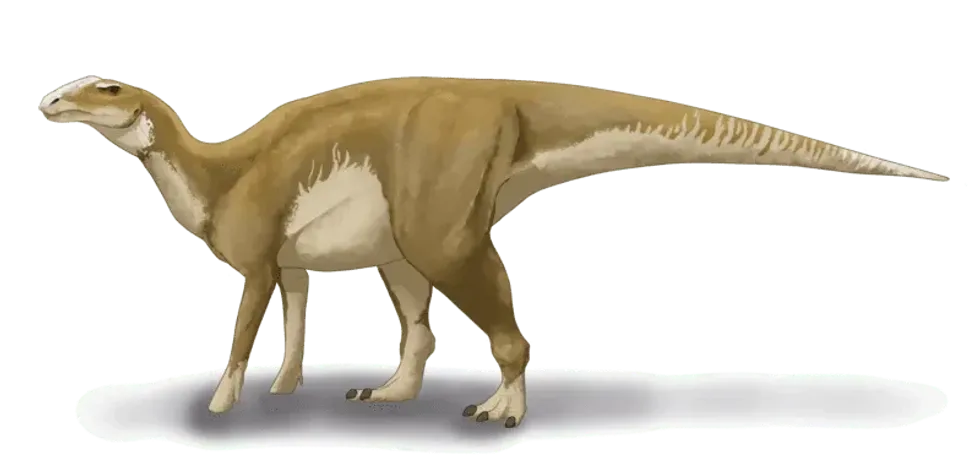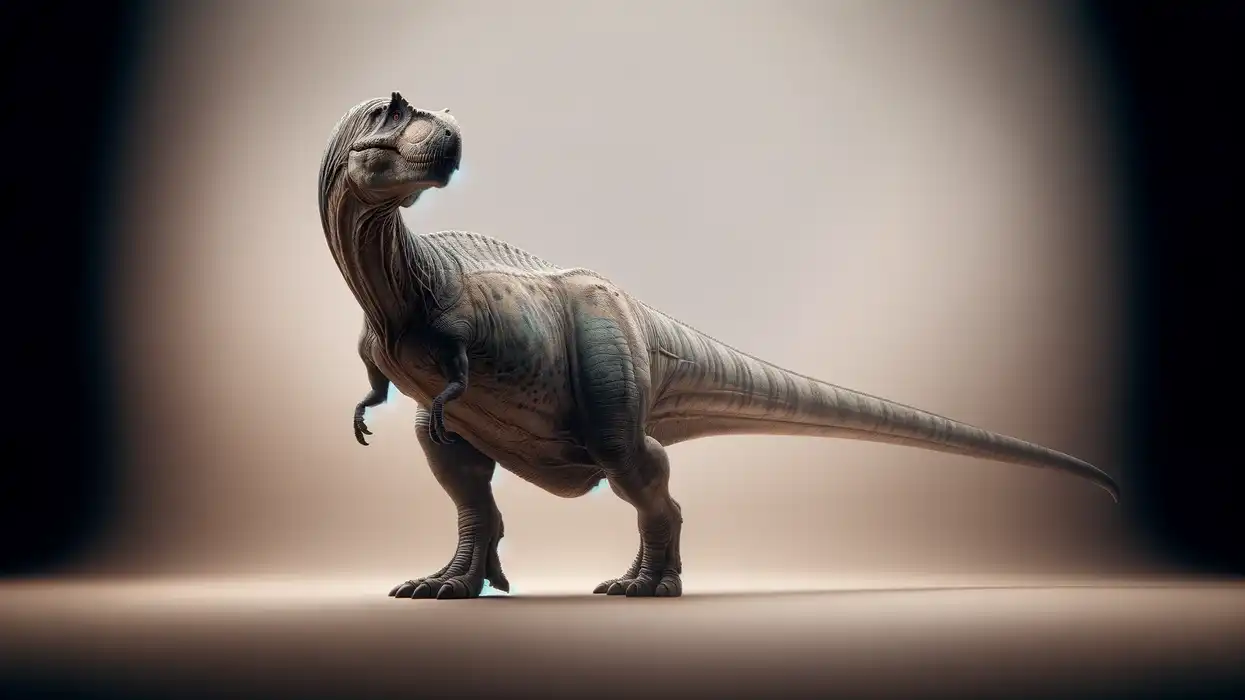Hadrosaurus was a dinosaur that lived in the Late Cretaceous period about 70-80 million years ago. Their bones were first discovered by John Estaugh Hopkins while digging a pit in New Jersey in 1838.
It was properly excavated by naturalist William Parker Foulke in 1858 while he was on a vacation and noticed the bones.
He then proceeded to call in his friend and paleontologist Joseph Leidy to help him out.
Both of them proceeded to recover around eight teeth fossil remains around the same pit and together, they studied these bones. In the same year, Foulke dug out the full skeleton.
After some deep study and research, these two friends named the dinosaur 'Hadrosaurus' which meant bulky lizard. The excavation site, known as the Hadrosaurus foulkii Leidy site, is now a National History Landmark.
In fact, New Jersey named this robustly built dinosaur as the official state dinosaur in 1991.
Hadrosaurus, which was a genus of Hadrosaurid dinosaurs, was a very important yet very unclear dinosaur.
Being the first nearly complete dinosaur skeleton fossil to be discovered in North America, these dinosaurs also traditionally served as the basis for a large subfamily called Hadrosaurinae, which was seen as a group of largely crestless hadrosaurs related to the crested subfamily Lambeosaurinae. From their discovery, a lot of unique characteristics were found.
They are often referred to as 'duck-billed dinosaurs' since they had a wide and flat beak-like structure from the front of their skull. Some members of this hadrosaur group were believed to have had some huge crests on their foreheads that worked well in chasing away certain enemies and predators.
The forelimbs were not as strongly built as the hindlimbs and hence, the hindlegs would have contributed to them being fast runners.
The stiff tail, supported by ossified tendons, and their sturdy bones and teeth structure suggest that the hadrosaurus dinosaur spent most of its life on land, although close to bodies of water, feeding on tough terrestrial plants.
Many paleontologists also believe that the feet of these unique dinosaurs may have been webbed and must have also had pads like those seen on camel feet! Continue reading for such interesting Hadrosaurus facts.
If you'd like to learn more about similar dinosaurs, check out our Puertasaurus interesting facts or Chungkingosaurus fun facts for kids that you're sure to enjoy!
Hadrosaurus Interesting Facts
How do you pronounce 'Hadrosaurus'?
These 'duck-billed' dinosaurs lived in North America during the Late Cretaceous period. The hadrosaurus pronunciation is 'Had-row-sore-us'.
What type of dinosaur was a Hadrosaurus?
Hadrosaurus foulkii was a genus of hadrosaurid ornithopod dinosaurs that lived about 78 -74 million years ago and Hadrosaurus fossil remains were found in New Jersey, USA. The discovery of this 'duck-billed' dinosaur was made by John Estaugh Hopkins in a marl pit who placed the fossil bones in his home at Haddonfield, New Jersey.
These bones sparked the interest of an American naturalist, William Parker Foulke who dug out the almost complete Hadrosaurus skeleton from the same marl pit!
In which geological period did the Hadrosaurus roam the earth?
This Hadrosaurus dinosaur was believed by paleontologists to have lived around the Late Cretaceous period about 80 million years ago. They were a famous dinosaur species since it was the most complete dinosaur skeleton excavated anywhere around the world!
When did the Hadrosaurus become extinct?
Many researchers and paleontologists concluded that the last specimen lived in the Iberian Peninsula for the purpose of stating that they were the last of their type to occupy Europe before disappearing during the Cretaceous-Tertiary extinction event that took place about 65.5 million years. Hence, these 'duck-billed' dinosaurs became extinct about 66.5 million years ago!
Where did a Hadrosaurus live?
This herbivorous dinosaur, which was once part of the Hadrosaurinae group of dinosaurs, lived in North America and made their homes in terrestrial habitats.
What was a Hadrosaurus's habitat?
The Hadrosaurus's habitat was largely known to be on land, however, still near the water like estuaries, wetlands, and shorelines and preferred moderate to warm climates. This large dinosaur species was known to share its habitat with other dinosaurs like Maiasaura, Shantungosaurus, and Edmontosaurus dinosaurs that were herbivores too.
Who did a Hadrosaurus live with?
A Hadrosaurus dinosaur, which is also the official state dinosaur of New Jersey, was believed to have lived in small herds, often grazing and moving to new habitats together.
How long did a Hadrosaurus live?
The life expectancy of these large dinosaurs was believed by many scientists and paleontologists to have been about 70-80 years.
How did they reproduce?
Very little is known about the way these dinosaurs reproduced. These herbivores were largely oviparous. This meant that reproduction was done by the female laying eggs. The discovery of fossilized nests and even young hadrosaurs' fossil remains signify that these animals displayed parental care and attended to their babies.
Hadrosaurus Fun Facts
What did a Hadrosaurus look like?

This sturdy large dinosaur species, which belongs to the Hadrosauridae family, was suspected to have been quite small at its emergence but they evolved to a larger size during the Cretaceous period in North America.
To date, this dinosaur is believed to be the only species of its genus and so some paleontologists speculate that this hadrosaur must have belonged to another genus of 'duck-billed' dinosaur.
With a few bones being found by John Hopkins, the almost complete skeleton was unearthed by William Foulke in 1858 in the same area where the bones were found. He later invited his friend, Joseph Leidy, a famous American paleontologist to study the dinosaur skeleton with him.
Measuring 30 ft (9.1 m) from head to tail and weighing about a few tons, the Hadrosaurus had rostral bones that were laterally stretched and a little flat, giving them a duck-bill look.
Its two hind legs were much more strongly built than its forelimbs, making them good runners!
How many bones did a Hadrosaurus have?
There is not much information on the number of bones that these hadrosaur species that were described by Joseph Leidy had but they must have definitely had over 200 bones!
How did they communicate?
Of course, being dinosaurs, a certain level of non-verbal dialogue took place between these large dinosaurs whose fossils were discovered in a marl pit in Haddonfield, New Jersey. This communication included loud calls, growls, body movements, and so on.
How big was a Hadrosaurus?
The Hadrosaurus was massive with a stiff tail and its complete skeleton was unearthed in 1858. They were about 39.4 ft (12 m) long, the same as a whale shark, and about 10-40 ft (3-12.1 m) in height, like a Dromedary camel!
How fast could a Hadrosaurus move?
These dinosaur species were quite fast. They were suspected to be the fastest while hopping, covering a distance of about 38 mph (61.1 kph)!
How much did a Hadrosaurus weigh?
The weight of a Hadrosaur was about 6000 lb (2721.55 kg), the same as a blue whale's tongue!
What were the male and female names of the species?
There are no sex-specific male or female names for these 'bulky lizard' species.
What would you call a baby Hadrosaurus?
The babies of these animals are called hatchlings or nestlings. They ate fruits, leaves, and other plant materials.
What did they eat?
The Hadrosaurus diet consisted largely of plant matter. Sharing similar diet patterns with sheep, deers, and giraffes, they were often found grazing in small herds in terrestrial habitats.
How aggressive were they?
Hadrosaurs were social animals. They had no tusks, horns, or body armor to protect them. Hence, they wouldn't have necessarily been aggressive but they would have displayed a certain level of aggression if they or their habitats were threatened.
Did you know...
In 1868, the complete dinosaur skeleton was put together by a team headed by Benjamin Waterhouse Hawkins and was then put on display at the Philadelphia Academy of Natural Sciences. It was the first-ever dinosaur skeleton in the world to be put up for public display.
When the skeleton was originally put together, it was displayed with a reconstructed skull sculpted by Hawkins. All recreations of this dinosaur have been made using the head of a Gryposaurus!
What does the name Hadrosaurus mean?
The Hadrosaurus name means 'bulky lizard'. William Foulke and Joseph Leidy named this dinosaur. This American dinosaur specimen has found its home at the Academy of Natural Sciences in nearby Philadelphia.
Who collected the first Hadrosaurus fossils?
The first Hadrosaurus fossils were collected by John Estaugh Hopkins when he was digging a marl pit in New Jersey, USA, in 1858. Hadrosaurus was the first nearly complete dinosaur skeleton to have been ever discovered and was also the first dinosaur to be mounted for public display.
Here at Kidadl, we have carefully created lots of interesting family-friendly dinosaur facts for everyone to discover! Learn more about some other creatures from our Hesperosaurus facts for kids, or Xenotarsosaurus interesting facts for kids.
You can even occupy yourself at home by coloring in one of our free printable Hadrosaurus coloring pages.










